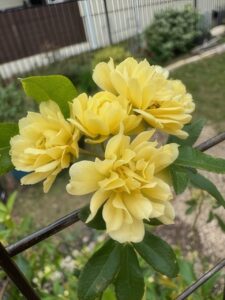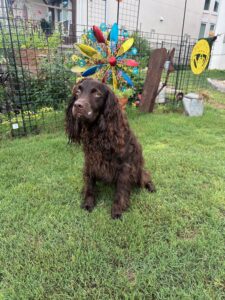Just this past weekend football season began in earnest. It is quite a big deal here with the MaryBird’s Backyard Garden crew. We have been gabbing about teams and projected outcomes of the season for a couple of weeks now and Jeff decided to get the party in full swing by going to the store for an opening day party smorgasbord.
He came in through the back door swinging loads of snacking supplies with an extra surprise in his hand. There sitting in his palm, was the cutest Kalanchoe. Sitting above the glossy, dark green leaves there were three vibrant orange blooms; along with more buds getting ready to open. Well, that made my day.
Jeff had brought home one of the most gifted plants we have available today. Kalanchoes are wonderful. They are super as houseplants, readily found in most groceries, home centers and garden centers and they bloom for an extended period of time. Let me tell you a little bit about these plants including information that I didn’t know before now.
The first thing most people discuss is the “proper” pronunciation of Kalanchoe. I originally learned to say Cal-AN-cho-a. With a long o. Today it is called Calen-KO-e also with a long o. Many of the translation sites I looked up support the second pronunciation. Old habits are hard to break I guess.
Kalanchoes are members of the Crassulasceae family which includes the fabulous Jade plant we love to grow. They are found natively in Madagascar and tropical Africa. There are between 168 – 200 species mentioned as belonging to this genus of plants. In 1763 Michael Adamsen, a French botanist, named the Kalanchoe after the Chinese name for a species in this genus.
Our lovely colorful plant, Kalanchoe blossfeldiana, was discovered in Madagascar in 1926. Robert Blossfeld introduced this species into Europe in 1930 and the early 2000’s saw the double blooming introduction come on the market.
It is important to note here that Kalanchoes are toxic plants. Use caution and commonsense about placing them where pets or children could take a bite out of them. I believe this applies to Jade plants and other succulents like Aloe as well.
Kalanchoes are perennial evergreens which, if grown in ideal environments for them, can be shrubby plants reaching 3-4 feet tall. They love zones 10-12 and enjoy living above 45 – 50 degrees Fahrenheit. Which is 7.2 – 10 degrees Celsius. They are also low water plants being succulents that thrive in morning sun with a shaded afternoon. I was pleasantly surprised to hear some discussion of growing Kalanchoes in our gardens here in zone 9A with protection during cooler weather.
The houseplant that Jeff brought home is a K. blossfeldiana. This cheerful variety is found frequently around town and makes a great houseplant. The leaves are dark green with a glossy surface. It may grow to 1 ft. x 1 ft. mature size in good conditions. They like good bright light without letting the hot sun’s rays burn the leaves. You can tell by the leaves getting dark spots or crispy edges.
K. blosssfeldiana has blooms in pink, white, orange and reds. It may be a double bloom with delicate frilly petals. If grown on the patio or porch these blooms may attract hummingbirds. So once your blooms have faded and you have pruned them back to the leaf before the bloom your plant may enter a resting period. I like to give them a bit of time to just be pretty as a green plant. Then in about 4 weeks you can cut back on the water and create an artificial light schedule. Keep your plant in the dark at night for 14 or more hours and the light for 10 hours. Do this for 6 weeks and see if you can encourage them to bloom again.
So, a few weeks ago we talked about picking up a plant called Flapjacks while out. Surprisingly it turns out to be a Kalanchoe as well. The official name is Kalanchoe thyrsiflora. Another name for it is the paddle plant. Very apt because the leaves form around the base in a rosette shaped like ping pong paddles in a way. This variety is very sun tolerant and just beautiful potted up in a terracotta pot. I discovered that it is a monocarpic (blooms once then dies) variety. There are reported blossoms of yellow, tubular flowers which last for more than one month. Our variety has colorful leaves in hues of yellow, orange and light green.
There are three varieties on my radar now that I ran across their pictures. The first is K. humilis. It is commonly called the Pen Wiper or Spotted Kalanchoe. The photo showed the most gorgeous gray, velvety leaves spotted with a dark brown or purplish color. It is described as reaching a size of 2 feet x 2 feet. I am looking for the “Desert Surprise” variety during our plant shopping expeditions.
Next on my list is K. daigremontiana. The common name is peaking my interest as it is called Mother of Thousands. According to what I read the leaves of mature specimens grow platelets along the margins. These platelets drop and form new plants that you can then repot as you wish. These were suggested to be great grown in containers surrounded by sedums. Hmmmmm, sounds like a project for sure. This variety is described as well suited to rock gardens.
This last variety has me jumping up and down to look for it. K. pumila is also known as Flower Dust Plant or Dwarf Kalanchoe. It is tiny. Just 8 inches x 8 inches it has a great impact from the delicately arching stems in silvery gray with pink blooms appearing on the ends. This little specimen looks perfect for a desk top companion.
We had a terrific weekend of football and the highlight of my day was the orange Kalanchoe Jeff brought home with him. I am looking forward to growing many more varieties of the Kalanchoe. Now, I must learn if they do well under grow lights…….
Happy gardening to you all,
Mary






